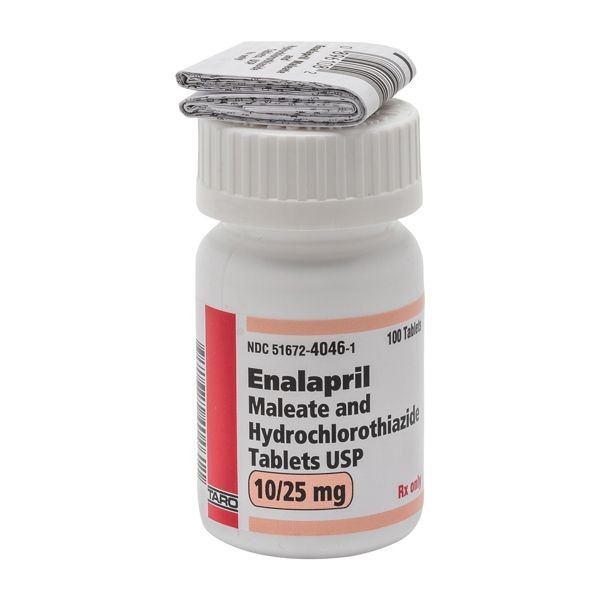
Contents
- 1 Enalapril and Hydrochlorothiazide (Vaseretic)
- 1.0.1 Side effects of enalapril and hydrochlorothiazide
- 1.0.2 What is the dosage for enalapril and hydrochlorothiazide?
- 1.0.3 Is enalapril and hydrochlorothiazide safe to take during pregnancy or breastfeeding?
- 1.0.4 Additional information about enalapril and hydrochlorothiazide
- 1.0.5 Summary
- 1.0.6 Related Disease Conditions
- 1.1 High Blood Pressure (Hypertension)
- 1.2 Kidney (Renal) Failure
- 1.3 Diabetes (Type 1 and Type 2)
- 1.4 Congestive Heart Failure (CHF)
- 1.5 Heart Attack (Myocardial Infarction)
- 1.6 Key Information About High Blood Pressure Treatment
- 1.7 Sun-Sensitive Drugs (Photosensitivity to Drugs)
- 1.8 Heart Attack Prevention
Enalapril and Hydrochlorothiazide (Vaseretic)
Vaseretic is a combination of enalapril and hydrochlorothiazide (HCTZ) used to treat high blood pressure (hypertension). It belongs to a class of drugs called angiotensin converting enzyme (ACE) inhibitors. ACE is an enzyme in the body that forms angiotensin II. Angiotensin II causes the muscles surrounding the arteries to contract, narrowing the arteries and increasing blood pressure. Enalapril (Vasotec) lowers blood pressure by preventing the formation of angiotensin II, relaxing the arteries.
HCTZ is a diuretic (water pill) used to treat high blood pressure and fluid accumulation. It blocks salt and water reabsorption in the kidneys, increasing urine output. The mechanism by which it lowers blood pressure is not well understood. The combination of enalapril and HCTZ reduces blood pressure more effectively than either drug alone. Vaseretic was approved by the FDA in October 1986.
Available brand names for enalapril and hydrochlorothiazide
Is enalapril and hydrochlorothiazide available as a generic drug?
Do I need a prescription for enalapril and hydrochlorothiazide?
Side effects of enalapril and hydrochlorothiazide
The side effects of Vaseretic are similar to those of the individual component drugs:
- A dry, persistent cough is a common side effect of ACE inhibitors. The cough resolves after discontinuing the medication.
Other side effects of ACE inhibitors include:
- abdominal pain,
- diarrhea,
- dizziness,
- fatigue,
- headache,
- loss of appetite,
- nausea and vomiting,
- chest pain,
- fainting,
- sexual dysfunction,
- increased potassium levels,
- numbness or tingling in the hands or feet,
- rash, and
- a sore or swollen throat.
In rare instances:
- liver dysfunction and skin yellowing (jaundice) have been reported with ACE inhibitors.
- In susceptible individuals, ACE inhibitors may reduce kidney function. Enalapril may cause hypersensitivity (allergic) reactions and angioedema (swelling of the face, lips, tongue, and throat).
Side effects of HCTZ include:
- weakness,
- low blood pressure,
- sunlight sensitivity,
- impotence,
- nausea,
- abdominal pain,
- electrolyte disturbances,
- pancreatitis,
- jaundice,
- anaphylaxis, and
- mild or severe rashes.
Patients who are allergic to sulfa may also be allergic to HCTZ due to the similarity in the chemical structure of the medications.
QUESTION
What is the dosage for enalapril and hydrochlorothiazide?
If enalapril or HCTZ alone is not sufficient, patients may be started on 10/25 mg/mg of Vaseretic. The dose may be increased after 2-3 weeks if necessary. The maximum dose is 2 tablets of 10/25 mg/mg once daily.
Is enalapril and hydrochlorothiazide safe to take during pregnancy or breastfeeding?
ACE inhibitors, including enalapril, should be avoided during breastfeeding.
Additional information about enalapril and hydrochlorothiazide
Available preparations of enalapril and hydrochlorothiazide
Tablets (mg enalapril/mg HCTZ): 5/12.5 and 10/25
How should enalapril and hydrochlorothiazide be stored?
Vaseretic should be stored at 15C to 30 C (59 F to 86 F) and protected from excessive light and humidity.
Summary
Enalapril and hydrochlorothiazide (Vaseretic) is a drug prescribed to treat high blood pressure. Before taking this medication, it is important to review the side effects, drug interactions, pregnancy safety, and warnings and precautions associated with it.
Related Disease Conditions
High Blood Pressure (Hypertension)
High blood pressure (hypertension) is a disease in which the pressure within the body’s arteries is elevated. Approximately 75 million people in the US have hypertension (1 in 3 adults), and only half of them are able to manage it. Many individuals are unaware that they have high blood pressure because it often has no warning signs or symptoms. Blood pressure is measured in two readings: systolic and diastolic. According to the American College of Cardiology, normal blood pressure is 120/80 mmHg. If either number is higher, high blood pressure is present. The American Academy of Cardiology defines high blood pressure as 130/80 mm Hg. or greater for either number, indicating stage 1 hypertension. Stage 2 hypertension is defined as 140/90 mm Hg. or greater. Individuals with high blood pressure are at risk for serious health conditions such as stroke and heart attack. Reference: CDC. High Blood Pressure. Updated: Nov 13, 2017.
Kidney (Renal) Failure
Kidney failure can occur from an acute event or a chronic condition or disease. Prerenal kidney failure may be caused by blood loss, dehydration, or medication. Some of the renal causes of kidney failure include sepsis, medications, rhabdomyolysis, multiple myeloma, and acute glomerulonephritis. Postrenal causes of kidney failure include bladder obstruction, prostate problems, tumors, or kidney stones. Treatment options include diet, medications, or dialysis.
Diabetes (Type 1 and Type 2)
Diabetes is a chronic condition characterized by high levels of sugar (glucose) in the blood. The two types of diabetes are type 1 (insulin dependent) and type 2 (non-insulin dependent). Symptoms of diabetes include increased urine output, thirst, hunger, and fatigue. Treatment depends on the type of diabetes.
Congestive Heart Failure (CHF)
Congestive heart failure (CHF) refers to a condition in which the heart is unable to function properly. Heart disease, high blood pressure, diabetes, myocarditis, and cardiomyopathies are among the many potential causes of congestive heart failure. Signs and symptoms may include fatigue, breathlessness, palpitations, angina, and edema. To diagnose congestive heart failure, a physical examination, patient history, blood tests, and imaging tests are typically performed. Treatment consists of lifestyle modifications and taking medications to decrease fluid in the body and ease the strain on the heart. The prognosis depends on the stage of heart failure and the individual’s overall condition.
Heart Attack (Myocardial Infarction)
A heart attack occurs when a blood clot completely blocks a coronary artery that supplies blood to the heart muscle. Learn about warning signs, causes, complications, risk factors, and treatment options.
Key Information About High Blood Pressure Treatment
High blood pressure (hypertension) is characterized by high pressure in the arteries. Treatment includes lifestyle modifications (e.g. alcohol reduction, smoking cessation, diet and exercise) as well as medications such as ACE inhibitors, angiotensin receptor blockers, beta blockers, diuretics, calcium channel blockers (CCBs), alpha blockers, clonidine, minoxidil, and Exforge.
Sun-Sensitive Drugs (Photosensitivity to Drugs)
Sun sensitivity (photosensitivity) is an inflammation of the skin caused by a combination of medications or substances and sunlight. Symptoms include redness, similar to a sunburn. These reactions can be either phototoxic or photoallergic, with phototoxic reactions being more common. Symptoms of phototoxic reactions include burning, stinging, and redness of the affected area. Symptoms of photoallergic reactions include itching, redness, swelling, and blisters. Treatment involves discontinuing the medication and applying topical creams.
Heart Attack Prevention
Heart disease and heart attacks can be prevented through a healthy lifestyle, including a nutritious diet, regular exercise, and stress management. Symptoms of a heart attack in men and women may include chest discomfort, shoulder pain, neck pain, jaw pain, stomach pain, or back pain.


